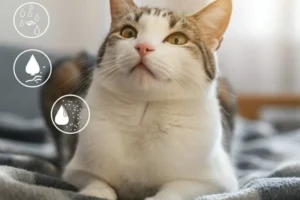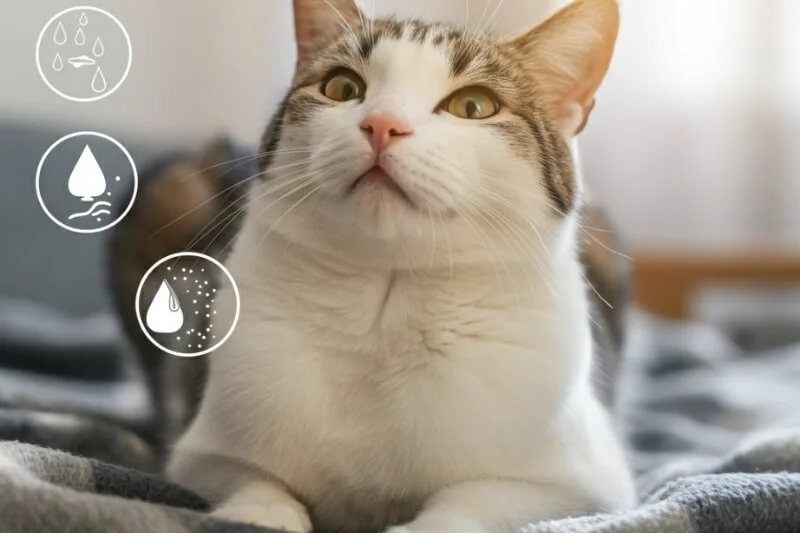
Cat Sneezing and Watery Eyes: Causes, Symptoms, and Solutions

A sudden sneeze from your cat can be cute. However, when it happens repeatedly, accompanied by watery eyes, it’s natural to feel concerned. Is it just a bit of dust, or is something more serious going on? Cat sneezing and watery eyes are common symptoms, ranging from little irritations to underlying health conditions.
If you notice symptoms like nasal discharge or eye discharge, it’s essential to monitor your cat closely. While some of these signs may simply be due to dust or a mild allergy, they can also be early indicators of infection or more severe problems. Understanding common causes is the first step in providing your furry friend with the right care. This blog will walk you through the common reasons behind your cat’s symptoms, what to look out for, and when it’s time to consult a veterinarian.
Table of Contents
Common Causes Of Cat Sneezing And Watery Eyes
“Why is my cat sneezing?” is a frequent question vets hear. Sneezing is simply the body’s way of clearing irritants from the nose. While an occasional sneeze is normal, persistent sneezing often has a specific cause and may be linked to issues such as nasal discharge, eye discharge, or even feline conjunctivitis.
- IRRITANTS AND ALLERGY
Cats can be sensitive to certain aspects of their environment. Inhaling dust, pollen, mold, or even strong smells from perfumes and household cleaning products can irritate their nasal passages and trigger a sneezing fit. Food allergies, though less common, can also sometimes present with nasal discharge or respiratory symptoms. If you find that your cat develops a runny nose or watery eyes after exposure to certain items, consider whether an allergy could be the common cause.
- UPPER RESPIRATORY INFECTION AND VIRAL INFECTION
Upper respiratory infections in cats and other viral infections that resemble the flu or cold in humans. Cat colds are sometimes caused by viruses such as feline calicivirus or feline herpesvirus. These illnesses can cause issues like sneezing, nasal discharge, and watery eyes. Feline respiratory infections can be highly contagious, especially in multi-cat households or shelters, and they may progress to involve other symptoms such as eye discharge and coughing. Monitoring your cats for these symptoms is essential so you can provide timely care before a minor problem escalates.
- FOREIGN OBJECTS
Curious by nature, cats sometimes inhale small foreign objects. For example, a blade of grass, a speck of dust, or a piece of litter can become lodged in a cat’s nose, causing persistent sneezing, nasal discharge, and sometimes even eye watering due to irritation. In rare cases, prompt removal by emergency veterinarians may be necessary if the item does not dislodge on its own.
- DENTAL ISSUES
It might seem unrelated, but your cat’s teeth can affect their sense of smell. The roots of the cat’s upper teeth are located right next to the nasal passages. If a tooth becomes infected or abscessed, bacteria can invade the sinus cavity, leading to inflammation, nasal congestion, and occasionally, sneezing. Dental infections are a common cause of chronic nasal discharge in cats. Maintaining regular dental care is crucial to preventing this chain reaction.
- NASAL POLYPS, TUMORS, AND UPPER RESPIRATORY TRACT INFECTION
Chronic sneezing and nasal discharge can sometimes result from nasal polyps (benign growths) or, less commonly, tumors. These can develop within the nasal passages, particularly in older cats, and lead to persistent symptoms. An upper respiratory tract infection, although less commonly used as a term, can describe infections affecting the nose, throat, and sinuses collectively.
Understanding Nasal Discharge and Eye Discharge
Nasal discharge (a runny nose) and eye discharge are common symptoms that indicate a wide range of concerns. Some cats may develop only one or the other, while others experience both. The type and appearance of discharge, whether it’s clear, cloudy, yellow, or green, helps your veterinarian determine if an infection is present and, if so, whether it might be bacterial or viral.
Watery eyes are often mistaken for a minor annoyance, but in cats, persistently runny eyes can signal a more serious health issue. Cat eye discharge is not only unsightly but may also indicate a more serious problem, such as a bacterial or viral infection. Eye infections in cats can cause squinting, redness, and thicker discharge, often requiring prompt treatment.
When is Eye Watering a Concern?
Eye watering can be a result of irritation, but recurrent or persistent watering could signal problems such as conjunctivitis, a developing eye infection, or a blocked tear duct. Sometimes, even an allergy can cause both nasal and eye discharge. An eye infection or foreign object in the eye should never be ignored, as a delay in treatment may lead to complications in the future. Serious concerns like these should never be ignored.
Cat Colds, Feline Calicivirus, and Eye Conditions
When people refer to “cat colds,” they typically mean mild upper respiratory infections, such as those caused by feline calicivirus. This viral infection often presents with symptoms such as sneezing, nasal discharge, mild eye discharge, and occasionally oral ulcers. Most cats recover well with supportive care; however, it is essential to monitor for secondary signs of infection, as some cases can develop into more severe illnesses.
Since some infections can cause both nasal and eye issues, it is crucial to keep an eye on your cats for repeated bouts of sneezing, a runny nose, and eye watering. Notably, certain breeds with flat faces, like Persians, may be more prone to having runny eyes due to the structure of their faces, so understanding your particular cat’s needs is important.
Recognizing and Managing Eye Infections
Cats are susceptible to several types of eye infections, some of which can develop into recurring infections if left untreated. Eye infections could be viral, bacterial, or sometimes even fungal. The most common symptom is eye discharge, which can be watery or thick, clear or colored, depending on the underlying cause. Squinting, redness, and sensitivity to light are other symptoms you might observe.
Certain cats develop chronic or recurrent infections. If you notice that your cats frequently have eye discharge or nasal discharge, especially if accompanied by lethargy or refusal to eat, consult a veterinarian. Internal medicine specialists may become involved in cases of deep-seated or persistent infections that don’t respond to standard treatment.
Treatment usually involves cleaning the eyes, administering prescribed eye drops, and possibly oral medication, depending on the severity and underlying infection. Avoid trying over-the-counter products without veterinary guidance, as not all human treatments are safe for cats.
When to Be Concerned: Red Flags That Warrant Emergency Care
If you notice unexpected symptoms in your cat, such as persistent eye discharge or nasal discharge, contact your veterinarian promptly to ensure timely and effective care. While some signs may be managed at home, certain symptoms require immediate attention. Contact emergency veterinarians if your cat experiences:
- Difficulty breathing, severe nasal congestion, or obvious distress
- Yellow, green, or bloody eye discharge or nasal discharge
- Extreme swelling around the eyes or nose
- Abrupt changes in behavior, such as hiding or refusing food
- Symptoms that worsen rapidly or fail to improve after a few days
Prompt emergency care ensures your cat gets timely treatment, which can sometimes be life-saving if the infection becomes severe.
The Role of Infection in Sneezing and Runny Eyes
Infection is one of the primary reasons cats develop sneezing, nasal discharge, and runny eyes. Various pathogens, including bacteria, viruses, and sometimes fungi, can invade the respiratory tract or eye tissues. Cats in shelters, including kittens and older cats, as well as those with weakened immune systems, are especially vulnerable. The infected cat may develop not only nasal and eye discharge but also lethargy and decreased appetite.
A respiratory infection, left untreated, can progress quickly. In such scenarios, it’s important to bring your cat to the vet before symptoms worsen.
Home Care Tips and Prevention for Cat Sneezing and Watery Eyes
Taking steps to maintain your cat’s health can go a long way in preventing sneezing, eye watering, and other issues. Here are a few tips:
- Routine wellness checks: Keep a close eye on your pet’s health by scheduling regular appointments with your veterinarian to check for early signs of infection or illness.
- Clean and allergen-free environment: Keep your cat’s litter box, bedding, and living space clean and free from allergens. Use dust-free litter and avoid air fresheners or cleaning products that may trigger allergies.
- Balanced nutrition: For a healthy immune system, a balanced diet and staying hydrated help reduce your susceptibility to infections and viral infections.
- Isolate new or sick animals: Feline respiratory infections spread easily. Give any sick pet a separate space and wash your hands thoroughly after contact.
- Watch for eye discharge and nasal discharge: Any persistent or unusual discharge from your cat’s eyes or nose should be checked by your veterinarian.
- Vet-prescribed medications: Only use eye drops or oral medications as directed by your vet. Never administer human medicine to your cat without first consulting a veterinarian.
Specialty Care: When to See Veterinary Specialists
Sometimes, symptoms such as chronic sneezing, persistent eye discharge, or recurring eye infections require an expert diagnosis and advanced treatment. Veterinary specialists, especially those working in internal medicine or ophthalmology, may use special instruments to inspect your cat’s eye or nasal passages, check for structural defects, and prescribe more targeted therapies.
Cats with anatomical issues, immune deficiencies, or a history of repeated infections will benefit from this advanced level of care. The earlier you address these issues, the better your cat’s chances for a full recovery.
Living With and Supporting Your Cat
Caring for cats means being alert to changes in their health and understanding what is normal for each individual cat. While not every sneeze or tear calls for concern, it’s crucial to distinguish between an occasional irritated nose and symptoms of an underlying health issue, such as an infection or a cold. By paying attention to signs like nasal and eye discharge, you can catch problems early and help your cat if it needs.
And remember, while cats are resilient animals, they rely on you to keep an eye on their well-being and to seek help when something seems off. Even if your cat hides symptoms, regular check-ups can spot problems before they turn serious.
Frequently Asked Questions (FAQ)
Can I use human eye drops for my cat's eye infection?
Never use medications designed for humans without veterinary approval. Some substances that are safe for people can be toxic to cats or exacerbate their symptoms. Always consult your vet for safe and targeted treatments if your cat is showing signs of an eye infection.
What’s the most common symptom of nasal discharge in cats?
The most common symptom preceding nasal discharge is sneezing. If the discharge persists, is discolored, or accompanied by other symptoms such as lethargy or coughing, contact your veterinarian as soon as possible.
How do emergency veterinarians treat an infected cat?
Emergency veterinarians will quickly assess your cat’s symptoms, determine the cause of the infection, and provide supportive care that may include fluids, antibiotics, or other necessary measures.
What is the best prevention for cat eye discharge and infections?
Maintaining a clean environment, providing proper vaccinations, and scheduling regular veterinary visits are the most effective prevention methods. If your cat has a history of allergies or infections, work with your veterinarian to create a personalized health plan.



